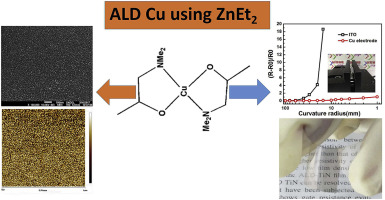Organic Electronics ( IF 3.2 ) Pub Date : 2018-03-21 , DOI: 10.1016/j.orgel.2018.03.036 Pengpeng Xiong , Yunfei Liu , Tao Ding , Ping Chen , Haoran Wang , Yu Duan

|
Ultrathin and continuous metallic films with mechanical robustness, high electrical conductivity and high elevated optical transparency are considered as ideal alternatives of the ITO electrodes. However, continuous and smooth morphology have not yet been simultaneously fully satisfied for making a rather thin metallic film. In this study, the atomic layer deposition (ALD) of copper ultrathin films was investigated at temperatures below 110 °C to obtain films used as transparent electrodes in flexible organic light-emitting devices with ITO-free electrode. During the process, ligand-exchange reaction of [Cu-(dmap)2] (dmap dimethylamino-2-propoxide) and diethyl zinc (Et2Zn) took place at the internal surface of the substrate at low temperatures. The data suggested that the deposition process at 110 °C followed an ideal self-limiting ALD fashion with a saturated growth rate of 0.022 nm/cycle. The resulting deposited Cu film with a thickness of 10 nm showed excellent surface morphology with a root-mean-square roughness value of 0.62 ± 0.03 nm. This led to favorable optical properties with a transparency of 74% at 550 nm wavelength and good conductivity with a sheet resistance of 10.2Ω sq−1. The use of the flexible ultrathin Cu films as anodes on Polyethylene terephthalate (PET) in OLEDs yielded higher luminance values when compared to OLEDs with traditional ITO anodes. Furthermore, the electrodes could be bent at less than 5 mm bending radius. The relevant device efficiency and superior luminance of the flexible ultrathin Cu anodes look promising as alternatives to ITO in flexible electronics.
中文翻译:

通过原子层沉积生产的基于超薄/超光滑铜膜的透明电极,作为新型无ITO有机发光器件
具有机械强度,高电导率和高光学透明性的超薄和连续金属膜被认为是ITO电极的理想替代品。然而,对于制备相当薄的金属膜,尚未同时完全满足连续和光滑的形态。在这项研究中,对铜超薄膜的原子层沉积(ALD)进行了研究,温度低于110°C,从而获得了用作具有无ITO电极的柔性有机发光器件中用作透明电极的膜。在此过程中,[Cu-(dmap)2 ](dmap二甲基氨基-2-丙氧基)与二乙基锌(Et 2Zn)在低温下在衬底的内表面上发生。数据表明,在110°C的沉积过程遵循理想的自限ALD方式,其饱和生长速率为0.022 nm /循环。所得的厚度为10nm的沉积的Cu膜显示出优异的表面形态,均方根粗糙度值为0.62±0.03nm。这导致了良好的光学性能,在550 nm波长下的透明度为74%,导电性良好,薄层电阻为10.2Ωsq -1。与具有传统ITO阳极的OLED相比,使用柔性超薄Cu膜作为OLED中的聚对苯二甲酸乙二醇酯(PET)的阳极产生了更高的亮度值。此外,电极可以以小于5mm的弯曲半径弯曲。柔性超薄铜阳极的相关器件效率和出色的亮度看起来有望成为柔性电子产品中ITO的替代品。



























 京公网安备 11010802027423号
京公网安备 11010802027423号